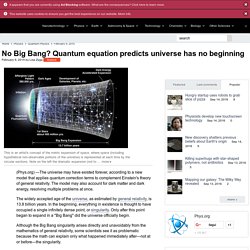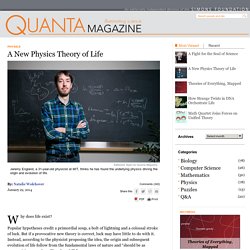

No Big Bang? Quantum equation predicts universe has no beginning. (Phys.org) —The universe may have existed forever, according to a new model that applies quantum correction terms to complement Einstein's theory of general relativity.

The model may also account for dark matter and dark energy, resolving multiple problems at once. The widely accepted age of the universe, as estimated by general relativity, is 13.8 billion years. In the beginning, everything in existence is thought to have occupied a single infinitely dense point, or singularity. Only after this point began to expand in a "Big Bang" did the universe officially begin. Although the Big Bang singularity arises directly and unavoidably from the mathematics of general relativity, some scientists see it as problematic because the math can explain only what happened immediately after—not at or before—the singularity. Old ideas revisited The physicists emphasize that their quantum correction terms are not applied ad hoc in an attempt to specifically eliminate the Big Bang singularity. A Religion for the Nonreligious. The mind…can make a heaven of hell, a hell of heaven. ― John Milton The mind is certainly its own cosmos. — Alan Lightman You go to school, study hard, get a degree, and you’re pleased with yourself.

But are you wiser? You get a job, achieve things at the job, gain responsibility, get paid more, move to a better company, gain even more responsibility, get paid even more, rent an apartment with a parking spot, stop doing your own laundry, and you buy one of those $9 juices where the stuff settles down to the bottom. But are you happier? But as you do these things day after day and year after year, are you improving as a human in a meaningful way? In the last post, I described the way my own path had led me to be an atheist—but how in my satisfaction with being proudly nonreligious, I never gave serious thought to an active approach to internal improvement—hindering my own evolution in the process. This wasn’t just my own naiveté at work. The Goal Wisdom. A Religion for the Nonreligious. The Learning Myth: Why I'll Never Tell My Son He's Smart My 5-year-old son has just started reading.

Every night, we lay on his bed and he reads a short book to me. Inevitably, he'll hit a word that he has trouble with: last night the word was "gratefully. " He eventually got it after a fairly painful minute. He then said, "Dad, aren't you glad how I struggled with that word? I think I could feel my brain growing. " Researchers have known for some time that the brain is like a muscle; that the more you use it the more it grows. However, not everyone realizes this. Christopher McDougall: Are we born to run? Fast Thinking and Slow Thinking Visualisation. Last week I attended the Association of American Geographers Annual Conference and heard a talk by Robert Groves, Director of the US Census Bureau.

Aside the impressiveness of the bureau’s work I was struck by how Groves conceived of visualisations as requiring either fast thinking or slow thinking. Fast thinking data visualisations offer a clear message without the need for the viewer to spend more than a few seconds exploring them. These tend to be much simpler in appearance, such as my map of the distance that London Underground trains travel during rush hour. The explicit message of this map is that surprisingly large distances are covered across the network and that the Central Line rolling stock travels furthest. Groundbreaking Idea Of Life's Origin.
Why does life exist?

Popular hypotheses credit a primordial soup, a bolt of lightning and a colossal stroke of luck. But if a provocative new theory is correct, luck may have little to do with it. Instead, according to the physicist proposing the idea, the origin and subsequent evolution of life follow from the fundamental laws of nature and “should be as unsurprising as rocks rolling downhill.” From the standpoint of physics, there is one essential difference between living things and inanimate clumps of carbon atoms: The former tend to be much better at capturing energy from their environment and dissipating that energy as heat.
Jeremy England, a 31-year-old assistant professor at the Massachusetts Institute of Technology, has derived a mathematical formula that he believes explains this capacity. Kristian Peters Cells from the moss Plagiomnium affine with visible chloroplasts, organelles that conduct photosynthesis by capturing sunlight. Courtesy of Jeremy England Wilson Bentley. Statistical physics of self-replication. Stuart Firestein: The pursuit of ignorance. Have you ever seen an atom?